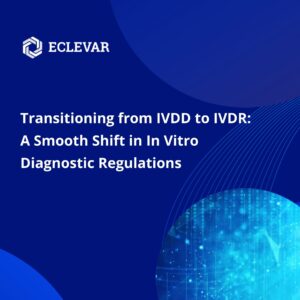Transitioning from IVDD to IVDR: A Smooth Shift in In Vitro Diagnostic Regulation
The IVDD’s regulation was based on conditions the device was designed to diagnose, grouped into extensive lists and annexes, corresponding each one to a level of classification that has it’s own regulatory requirements and standards.
This former type of classification depended on a predetermined list of pathologies, and for that reason no longer could respond effectively to new deadly conditions. The solution is to transport all the devices into IVDR, so we can overcome the issue.
Explore the seamless transition process from IVDD to IVDR for enhanced compliance and regulatory clarity. Stay updated with the latest changes and requirements in the field of in vitro diagnostics, below.
Transition period for the IVDD to IVDR adjustment
The original timeline for the application of the In Vitro Diagnostic Devices Regulation (IVDR) has been partially extended. Starting from 26th May 2022, manufacturers will no longer be able to issue new certificates for In Vitro Diagnostic Devices (IVDD).
However, they will be allowed to continue selling existing “legacy” devices that have already been placed on the European Union (EU) market for an additional 5 years, depending on their risk class, as long as no significant changes are made to their design or intended purpose.
It is important to note that any new devices introduced to the market must follow the revised rules of the IVDR. All devices, including both legacy and new ones, are required to conform to post-market surveillance, vigilance, and the registration of economic operators and devices starting from the original date of application, which is 26th May 2022.
Understanding the changes
Manufacturers who have already implemented a Quality Management System (QMS) are now faced with the task of managing the extended transition period. Over the next few years, they will be required to submit new products for approval under the revised regulations, that demands a comprehensive update to their QMS.
While certain aspects of the QMS, such as communication plans and revised responsibilities, can be immediately put into effect (including those concerning post-market surveillance), other elements may need to be implemented on a product-by-product basis, such as changes related to Unique Device Identification (UDI).
Now, manufacturers have options to consider when determining the best pathway in light of this situation:
Establish a new parallel QMS specifically tailored for the new In Vitro diagnostic regulation
This parallel system would facilitate a smooth progression from the old QMS to the new one, allowing each file to reference the appropriate procedures and making it unequivocally clear that the updated system is in place. This approach presents an opportunity for organizations with complex and long QMS histories to simplify their structure significantly, leading to greater efficiency rather than merely adding to the document.
Choosing this course of action may generate increase in cost and management efforts, as well as potentially introduce confusion among employees who must navigate and comply with two sets of processes simultaneously.
Update existing QMS documents to align with the IVDR requirements
This option is often by organizations that have a relatively small disparity between their current QMS and the revised IVDR requirements. However, a disadvantage of this approach is the presence of QMS components that cannot be universally applied to all products simultaneously.
Also, in certain cases, multiple options within a procedure may need to be implemented to differentiate devices based on whether they fall under the pre-transition or post-transition category.
Whichever approach is adopted
In order to ensure a smooth transition, proper documentation is essential to determine the applicability of new aspects within the Quality Management System. This can be achieved either by incorporating the transition details within the procedures themselves, specifying that they only apply to products registered under the In Vitro Diagnostic Regulation, or by outlining the transition plan separately, indicating which procedures are immediately applicable and which become applicable only after product registration.
It is important to recognize that this change in the QMS will likely be considered significant and should be communicated clearly to the notified body, following the established Change Control process.
Eclevar – Effective management for IVDD to In Vitro diagnostic regulation transition
Eclevar Medtech is a global CRO with experience in supporting medical device and IVD manufacturer in the MDR and IVDR transition. Our team works as an extension team of medical affairs and regulatory affairs sponsor.
In addition to provide services as biologic assay development, commercialization, clinical development, clinical trials management, and Real-world evidence, Eclevar is ready to simplify the regulatory pathway and give effective solutions for your devices’ IVDD to IVDR transition. Contact us for partnering up.

